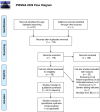Breast cancer in lesbians and bisexual women: systematic review of incidence, prevalence and risk studies
- PMID: 24313963
- PMCID: PMC3890640
- DOI: 10.1186/1471-2458-13-1127
Breast cancer in lesbians and bisexual women: systematic review of incidence, prevalence and risk studies
Abstract
Background: The UK Parliamentary Enquiry and USA Institute of Medicine state that lesbians may be at a higher risk of breast cancer but there is insufficient information. Lesbians and bisexual (LB) women have behavioural risk-factors at higher rates compared to heterosexuals such as increased alcohol intake and higher stress levels. Conversely, breast cancer rates are higher in more affluent women yet income levels in LB women are relatively low. This systematic review investigated all evidence on whether there is, or likely to be, higher rates of breast cancer in LB women.
Methods: Cochrane library (CDSR, CENTRAL, HTA, DARE, NHSEED), MEDLINE, EMBASE, PsychINFO, CAB abstracts, Web of Science (SCI, SSCI), SIGLE and Social Care Online databases were searched to October 2013. Unpublished research and specific lesbian, gay and bisexual websites were checked, as were citation lists of relevant papers. Included were studies in LB populations reporting breast cancer incidence or prevalence rates, risk model results or risk-factor estimates. Inclusions, data-extraction and quality assessment were by two reviewers with disagreements resolved by discussion.
Results: Searches found 198 references. No incidence rates were found. Nine studies gave prevalence estimates - two showed higher, four showed no differences, one showed mixed results depending on definitions, one had no comparison group and one gave no sample size. All studies were small with poor methodological and/or reporting quality. One incidence modelling study suggested a higher rate.Four risk modelling studies were found, one Rosner-Colditz and three Gail models. Three suggested higher and one lower rate in LB compared to heterosexual women. Six risk-factor estimates suggested higher risk and one no difference between LB and heterosexual women.
Conclusions: The only realistic way to establish rates in LB women would be to collect sexual orientation within routine statistics, including cancer registry data, or from large cohort studies.
References
-
- Anon. Report of the All Party Parliamentary Group on Cancer’s Inquiry into Inequalities in Cancer. London: All Party Parliamentary Group on Cancer; 2009.
-
- Institute of Medicine. The Health of Lesbian, gay, Bisexual and Transgender People: Building a Foundation for Better Understanding. Washington DC: The National Academies Press; 2011. - PubMed
-
- Wilton T. Sexualities in Health and Social Care. Buckingham: Open University Press; 2000.
-
- Boehmer U, Ozonoff A, Timm A. County-level association of sexual minority density with breast cancer incidence: results from an ecological study. Sex Res Soc Policy. 2013;13:139–145.
Publication types
MeSH terms
LinkOut - more resources
Full Text Sources
Other Literature Sources
Medical


